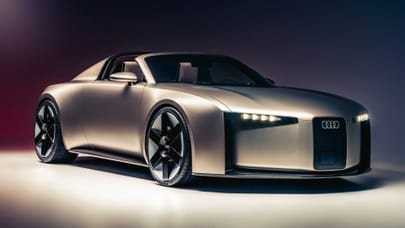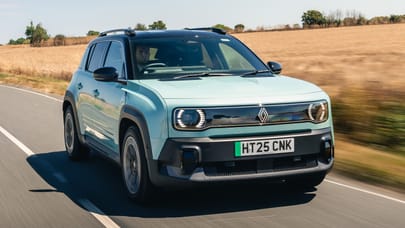
Power up: flat out on track in the 2,011bhp Lotus Evija
Time to get behind the wheel of the electrifying Lotus Evija on track. Buckle up...
A beautiful day in Wales and a Lotus. What could be simpler? Perfect tarmac, jaw dropping scenery and a pure, lightweight, throwback sports car. Apply a few cliches about adding lightness, the genius of Colin Chapman and a liberal sprinkling of ‘ride handling balance’ fairy dust and you have the formula that’s been on the rinse and repeat cycle in car magazines since the 1960s. Did I mention steering feel yet?
Don’t worry. It’s coming. But first, let’s throw out everything we know of how this tale goes. Today is truly a new day. The Lotus in question isn’t a sports car. The Evija is truly hyper. Fiendishly complex, hysterically powerful, mind meltingly expensive and (sadly for Lotus), likely to be as exclusive as ground unicorn horn.
The price of £2m plus taxes is a rather fundamental limiting factor, of course, but that’s nothing compared to the bleak market conditions. In 2019, when the Evija was first revealed, the world was hurtling towards EV domination and the unprecedented performance potential created dazzling new possibilities.
Photography: Jonny Fleetwood
In 2025 things aren’t so optimistic. In fact, while the mainstream is quickly retreating to hybrid, the hypercar customer has resoundingly opted out of the great electric revolution. Just ask Pininfarina or Rimac. So, right now and despite a Herculean effort by Lotus to bring the Evija to fruition, the “maximum of 130 cars” promise seems as overinflated as its total power output.
Yet even if the Evija’s stated sales target is DOA, it remains a fascinating car and seeing two parked side by side in a pit garage at Anglesey – the roadtrip comes later – is a very special moment. These are the most powerful production cars Top Gear has ever tested so the clear skies are a godsend, and later the unbroken sunshine will beautifully render every detail, duct and aero device. Why two? Well, with a 93kWh battery feeding four electric motors the range is, um, compromised. Lotus claims 195 miles but on a racetrack you can cut that in half, then maybe in half again. So having a spare seems prudent. Sensible, even.
Speaking of sensible, the Evija has a total power output of 2,011bhp. Remember the Lotus Carlton, the super saloon that prompted questions in parliament due to its irresponsible power output? Well, each one of the Lotus Evija’s wheels has 125bhp more than the Carlton’s total output. It can accelerate from 0–186mph in under nine seconds and hits 217mph. Zero to 60mph? Lotus simply says “less than three seconds”, but even one exploratory launch on Anglesey’s straight delivers an easy GPS verified two seconds. The performance is otherworldly and a huge departure from the usual Lotus ways.
Yet, rolling out of the pitlane there’s a very real feeling of two worlds colliding here. The full carbon fibre structure is extremely stiff, the interior wonderfully minimalist with lovely materials and the tiny yoke-like steering wheel feels delicious. These high end hypercar calling cards in combination with the manic whirr of the electric motors and instant, ear flattening performance suggest the Evija shouldn’t have a shred of Lotusness about it. Yet it does.
Top Gear
Newsletter
Thank you for subscribing to our newsletter. Look out for your regular round-up of news, reviews and offers in your inbox.
Get all the latest news, reviews and exclusives, direct to your inbox.
Much of it bubbles up through the steering. Lotus elected to stick with hydraulic power steering to ensure clarity of feedback and it feels like an inspired decision. The Evija might have alien performance but initially the sensations it provides are reassuringly familiar. There’s no heavy regen, either. God knows the battery could do with all the help it can get in terms of range, but I appreciate that lifting the throttle doesn’t artificially induce heavy negative g. In fact, programming in a tiny bit of regen wouldn’t be a bad idea as the Evija seems to freewheel when not under load.
Perhaps most satisfying is that the Evija feels light and lithe. As every Lotus should. With its exotic structure and a real focus on weightsaving, the Evija has been kept to 1,884kg. Heavy compared to, say, an Aston Martin Valkyrie, but literally hundreds of kilograms lighter than other EVs of this nature. With electronically adjustable Multimatic dampers and a heave damper to handle the huge downforce generated, body control is measured and, again, has an organic feel. As I gently increase the pace the Evija stays composed but breathes with the surface and has just enough movement on its suspension to impart information and breed ever more confidence.
The soundtrack increases in intensity, too. There’s no fakery here. The motors almost shriek under full power and while the noise isn’t spine tingling, the frenzied, runaway sense of it is perfectly in keeping with the performance, which borders on the surreal. Such is the assault on the senses that even the lack of a gearbox to control doesn’t seem a mortal fault. The Evija might not quite conform to all my usual mental markers, but it’s a deeply moving experience. A mix of high definition tactility and quantum performance.
The Evija is brutal yet oddly balletic at times, wild yet determinedly controlled
Yet, there are compromises. The sheer scale of performance on offer has led Lotus to a necessarily slightly conservative balance. On track we’re concentrating on Sport and Track modes (Valet, Range, City and Tour will be addressed later), but even fully wound up the Evija’s traction and stability control remains active at all times.
This measure seems wise when you see the telltale light on the dash flickering at 130mph in a straight line and feel the ever present torque steer as the Pirellis are stressed right to the limit. However, you’d think the watchful eye of the electronics might allow Lotus to really exploit the power of true torque vectoring. As each wheel can be controlled independently there’s a whole new world of possibility... but the Evija is neutral almost to a fault.
In Sport mode there’s a hint of understeer first and sometimes a tiny sliver of oversteer under power on corner exit but it’s almost imperceptible. Switch to Track mode and the Evija’s stability is incredible but there’s almost nothing by way of adjustability. Point, shoot, hope your neck muscles can take the beating. Repeat. It’s outrageous but the thrill is physical rather than an experience that conquers your heart and mind.
It’s funny, the only time the Evija feels slightly unruly is under full power in a straight line – where the front tyres can feel very sensitive to surface changes and cambers – and under heavy braking. There’s just not quite the stability you expect and because Lotus didn’t go for a ‘skateboard’ construction (instead building up the batteries where you’d find a V8 or V12 in a mid-engined supercar) the weight just behind your shoulders moves and shakes in ways that can feel pretty unnerving. Oh, and even six piston carbon ceramic brakes can’t handle 2,011bhp and 1,884kg for too long before the pedal starts to creep closer to the floor.
You might have noticed that I’ve avoided describing the raw performance up until now. Mostly because, well, it’s hard to put into words. Relentless? Yep, but that doesn’t quite do it justice. Sickening? Weirdly not. Perhaps the driving position and excellent body control help here, but the Evija is far less vomit inducing than a Tesla Plaid, for example. Extreme? Absolutely. The Evija makes something like a McLaren 750S feel very ordinary indeed. Unforgettable? Perhaps that sums it up best. Not just the acceleration but the whole car.
The Evija is brutal yet oddly balletic at times, wild yet determinedly controlled – a vast leap for Lotus but still clinging to the old ways where it can. It turns out there’s nothing simple about a sunny day in Wales and this Lotus. But I won’t forget it in a hurry.
Trending this week
- Car Review
BMW iX3











